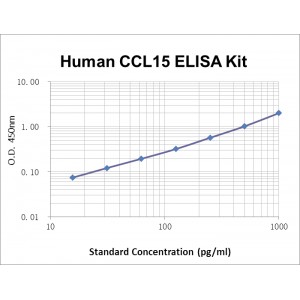More info
Assay Range | 15.6--1000 pg/mL |
Sensitivity | 10.0 pg/mL |
Size | 96T |
Storage | Store at 2 - 8ºC. Keep reconstituted standard and detection Ab at -20 ºC |
Assay Principle | Sandwich ELISA |
Sample volume | 100 µL final volume, dilution factor varies on samples |
Detection Method | Chromogenic |
Kit Components
1. Recombinant Human CCL15 standard: 2 vials
2. One 96-well plate precoated with anti-Human CCL15 Ab
3. Sample diluent buffer: 12 mL - 1
4. Detection antibody: 130 µL, dilution 1:100
5. Streptavidin-HRP: 130 µL, dilution 1:100
6. Antibody diluent buffer: 12 mL x1
7. Streptavidin-HRP diluent buffer: 12 mL x1
8. TMB developing agent: 10 mL x1
9. Stop solution: 10 mL x1.
10. Washing solution (20x): 25 mL x1.
Background
Chemokine (C-C motif) ligand 15 (CCL15), also known as chemokine CC-2 (HCC-2), leukotactin-1 (LKN-1), MIP-1 delta, macrophage inflammatory protein 5 (MIP-5), is a small cytokine belonging to the CC chemokine family. CCL15 is synthesized as a 113 amino acid (aa) protein containing a putative 21 aa signal peptide and a 92 aa mature protein. Three proteolytically cleaved isoforms of mature CCL15, CCL15(aa22-92), CCL15(aa25-92) and CCL15(aa29-92), have been identified and show more potent chemotactic activity than the full-length CCL15. Human CCL15 is expressed in T and B lymphocytes, NK cells, monocytes and monocyte derived dendritic cells. CCL15 is chemotactic for neutrophils, monocytes, and lymphocytes and elicits its effects by binding to cell surface chemokine receptors CCR1 and CCR3.


